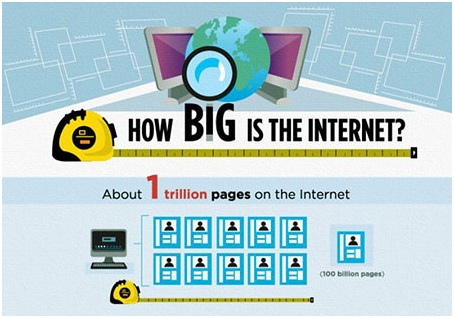Just How Big Is The Internet?

Thanks to high speed broadband and fast 4G mobile access, more people have the technology to use the internet more of the time than ever before. It is used for a huge range of tasks from shopping and banking to reading the news, finding entertainment and keeping in touch with friends.
What’s more, the web is a truly global space, used by people from all around the world. But how big is the internet? That’s a tricky question because it depends what you measure, but let’s have a look at some of the numbers.
In 2014 Google had indexed about 200 terabytes of data, but that’s only a tiny portion – less than half of one per cent – of the whole internet. The rate of growth is also phenomenal. To take just one site as an example, if you were to watch all of the videos that are uploaded to YouTube in an average day it would take you 16 years to get through them all.
Of course the web is used for a wide variety of tasks; Membership Management Systems have made it easier for clubs and societies to administer themselves; companies such as ofec.co.uk can create sites tailored to the needs of both large and small organisations.
We’re doing more of our shopping online too. Americans spent over $700 million a day online in 2013. But that’s still less than six per cent of the country’s total shopping spend so there’s room for the internet to get much bigger yet.
The social web has seen huge growth in recent years too. More than 100 million people now use Twitter every day and 757 million sign in to Facebook on a daily basis.
So much for data, but what about the number of devices and individuals online? Looked at in terms of population the internet is equally impressive. Over three billion people were online as of 2014, yet that’s still less than half of the global population. The proportion varies depending on where you are, while over 87 per cent of Americans and 70 per cent of Europeans are online that figure drops to less than 27 per cent in Africa.
As more intelligent devices come along and the ‘Internet of Things’ expands we’re likely to see a huge increase in the number of devices online. It is estimated that by 2020 there will be 7.3 billion PCs, tablets and smartphones online, but they will be dwarfed by 26 billion IoT devices as things like heating thermostats, fridges and even our cars go online. This will of course create additional traffic and place greater demands on infrastructure and ISPs.
All of the numbers in terms of volume of data and numbers of devices and users are pretty staggering. But if you look at it another way the internet is very insubstantial. If you take all of the electrons moving around the internet and add up the tiny amount of weight each one possesses, you come to a figure about 1.8 ounces. Which means the internet is about the size of a strawberry.
